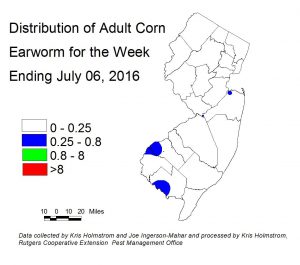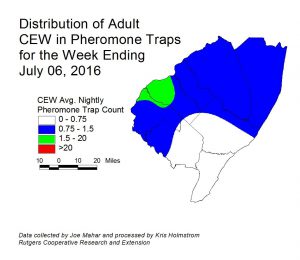European corn borer (ECB) moth catches remain very low now. Only scattered individuals are now being captured, and growers are managing residual infestations. At the present, the highest adult activity is in Salem county, although it is quite low even there (see ECB map). Larval feeding ranges from single digits to above 20% in areas where IPM personnel are operating. Be sure to begin monitoring plantings for ECB feeding while they are still in the whorl stage. Consider treating when the number of infested plants in a 50 plant sample exceeds 12%. Feeding in the whorl stage will appear as numerous small holes (called “shot-hole”) on leaves, with damage present on consecutively younger leaves. As plants progress to pre-tassel and beyond, droppings and larvae may be found in or on the emerging tassels. Any planting remaining at or above threshold as it proceeds to full tassel should be treated, as this is the last stage at which ECB larvae will be exposed and vulnerable to insecticidal sprays. Insecticides that are acceptable in organic production include the spinosyn based material Entrust (IRAC-5) and Dipel (IRAC-11a). The 10G formulation of Dipel is particularly useful when granules can be dropped or broadcast such that they get into the whorls of corn plants. Other effective insecticides include Coragen (IRAC 28), and the synthetic pyrethroids (IRAC 3). See the 2016 Commercial Vegetable Recommendations Guide for a more complete list of insecticides.
The highest nightly ECB catches for the previous week are as follows:
| Centerton 1 | Princeton 1 |
| East Vineland 1 | Springdale 1 |
| Pedricktown 1 | Woodstown 1 |
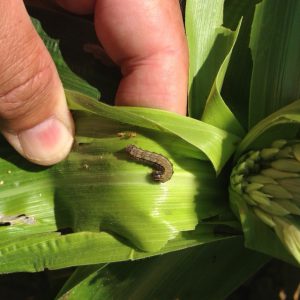 Low-level infestations of fall armyworm (FAW) continue to appear. Thus far, these have not appeared north of Hunterdon County, and all reports are that few plants are affected. It is likely that there are other infestations throughout the state. Injury should remain fairly low through mid-July. After this, large moth populations entering our area become more likely. FAW feeding is much more obvious than that of ECB larvae, with large ragged holes and conspicuous droppings found in the whorl. The larva is larger, and is general brown in color after it has molted twice (see photo at left). It is useful to note that FAW is less susceptible to the B.t. toxin found in older B.t. sweet corn lines. Therefore some FAW injury can still occur from seedling stage through ear development. FAW is also resistant to synthetic pyrethroid insecticides (IRAC 3), but can be effectively managed with insecticides such as Radiant/Entrust/Blackhawk (IRAC 5) or Coragen/Besiege (IRAC 28). Consider treating if damage from ECB and/or FAW reaches 12%.
Low-level infestations of fall armyworm (FAW) continue to appear. Thus far, these have not appeared north of Hunterdon County, and all reports are that few plants are affected. It is likely that there are other infestations throughout the state. Injury should remain fairly low through mid-July. After this, large moth populations entering our area become more likely. FAW feeding is much more obvious than that of ECB larvae, with large ragged holes and conspicuous droppings found in the whorl. The larva is larger, and is general brown in color after it has molted twice (see photo at left). It is useful to note that FAW is less susceptible to the B.t. toxin found in older B.t. sweet corn lines. Therefore some FAW injury can still occur from seedling stage through ear development. FAW is also resistant to synthetic pyrethroid insecticides (IRAC 3), but can be effectively managed with insecticides such as Radiant/Entrust/Blackhawk (IRAC 5) or Coragen/Besiege (IRAC 28). Consider treating if damage from ECB and/or FAW reaches 12%.
Corn earworm moth (CEW) captures in blacklights are low. Slightly higher activity is occurring along the Delaware Bay Shore (see CEW blacklight map), but scattered individuals have been captured as far north as Morris County.
The highest nightly CEW catches for the previous week are as follows:
| Allentown 1 | Jones Island 1 |
| Beckett 1 | Matawan 1 |
| Chester 1 | Pedricktown 1 |
| East Vineland 1 |
In addition, a limited number of CEW pheromone traps have been deployed throughout the southern counties. These traps have captured decreasing numbers of CEW moths over the past week. Highest activity from this network has been found in the Gloucester/Salem County area (see CEW pheromone map). The broad color patterns of this map are a result of the few numbers of contributing trap sites. Green areas on the map roughly correspond to a 4-5 day silk spray schedule, while blue areas would be 5-6 days. As sweet corn plantings begin to silk, it is critical that growers monitor local CEW moth numbers. For the present time, any sweet corn plantings in the silk stage should be treated to limit CEW injury as well as to prevent ear damage from ECB larvae that already inhabit the stalks.
The highest nightly CEW pheromone trap catches for the previous week are as follows:
| Pedricktown 2 | Springdale 1 |
| Beckett 1 | Woodstown 1 |
| East Vineland 1 |
For silking sweet corn, the following spray schedules are warranted.
Silking Spray Schedules*:
South – 5 days
Central – 6 days
North – 6-7 days
*These recommendations are based on regional catches.
Brown Marmorated Stinkbug (BMSB)
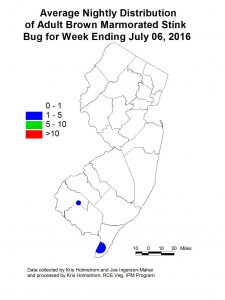 Although BMSB captures in NJ blacklight traps remains low, there were enough individuals caught this week to generate a map image. The highest activity is currently in Cape May County (see BMSB map). BMSB levels may yet rise, but at the present time, they are well below those seen in 2010-12. BMSB can be a pest on peppers, as well as sweet corn and beans.
Although BMSB captures in NJ blacklight traps remains low, there were enough individuals caught this week to generate a map image. The highest activity is currently in Cape May County (see BMSB map). BMSB levels may yet rise, but at the present time, they are well below those seen in 2010-12. BMSB can be a pest on peppers, as well as sweet corn and beans.
The highest nightly BMSB trap catches for the previous week are as follows:
| Green Creek 2 | Centerton 1 | Farmingdale 1 |
| Allentown 1 | Crosswicks 1 | Springdale 1 |
| Beckett 1 | Eldora 1 | Woodstown 1 |
Pumpkins and Winter Squash
These crops are now emerging in many areas. It is important to monitor frequently for the presence of striped cucumber beetles at this time, particularly if the seed was not purchased pre-treated with an insecticide for cucumber beetle. Check 5 consecutive plants each in 10 random locations. Examine upper and lower surface of seed leaves for the presence of beetles. Consider treating if beetles are found at 5 or more sites. Heavy, but local infestations may be spot treated. Management of these pests will limit the loss of plants to the bacterial wilt disease that the beetles transmit.
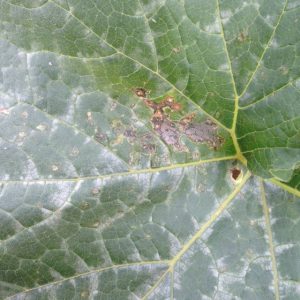
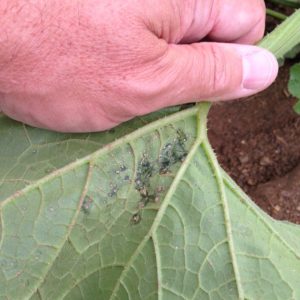 This week, several scouted fields have developed signs of bacterial leaf spot infection. Symptoms include dark lesions on the upper (photo at left) and lower (photo at right) leaf surface, typically near the point of attachment with the petiole, where water lays the longest. Lesions initially appear to be water-soaked, and “greasy”. As they age, they often dry up and the affected tissue falls out, leaving holes. While these infections do not often inhibit growth, they can, if left untreated, result in lesions on the surface of developing fruit. This results in blemished fruit that do not last long upon harvest. Applications of copper hydroxide are recommended to help limit symptoms. See the 2016 Commercial Vegetable Recommendations Guide for a listing of copper materials.
This week, several scouted fields have developed signs of bacterial leaf spot infection. Symptoms include dark lesions on the upper (photo at left) and lower (photo at right) leaf surface, typically near the point of attachment with the petiole, where water lays the longest. Lesions initially appear to be water-soaked, and “greasy”. As they age, they often dry up and the affected tissue falls out, leaving holes. While these infections do not often inhibit growth, they can, if left untreated, result in lesions on the surface of developing fruit. This results in blemished fruit that do not last long upon harvest. Applications of copper hydroxide are recommended to help limit symptoms. See the 2016 Commercial Vegetable Recommendations Guide for a listing of copper materials.
As scouted pumpkin and winter squash fields begin to develop fruit, we would expect to see powdery mildew (PM) develop. As yet, the most mature fields in the IPM Program are just reaching the vine-run stage and are free of powdery mildew. The action threshold for commencement of the protectant fungicide program for PM is 2 lesions per 100 older leaves.
A sentinel plot containing susceptible and resistant cucumber varieties, as well as muskmelons, watermelons, acorn and butternut squash and pumpkins is now established at the Snyder Research and Extension Farm in Hunterdon County. The purpose of this plot is to detect the presence of downy mildew (DM) in northern NJ. Any occurrence will be reported in this newsletter and will also generate an alert to all subscribers. For more information on the regional presence of DM as well as comprehensive, weekly forecasts, see the following website: http://cdm.ipmpipe.org/
Allium Leaf Miner
In case you missed it last week: A sample from Hunterdon County that was submitted to USDA for identification in May has returned a positive result. This is the first incidence of allium leaf miner in New Jersey. All growers of onions and related crops should familiarize themselves with the symptoms of leaf miner infestations on these plants. Information and photographs may be found at the following site: http://www.agriculture.pa.gov/Protect/PlantIndustry/Pages/ALLIUM-LEAFMINER.aspx#.VyCuc6PD-Ik

